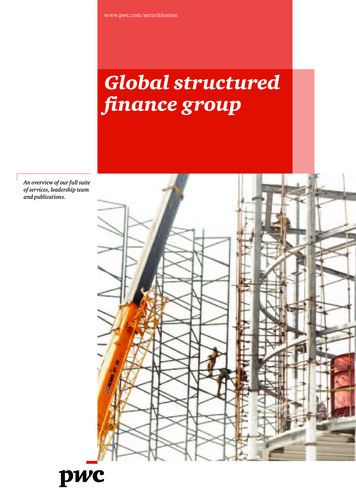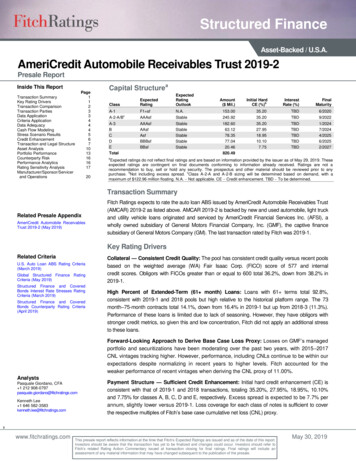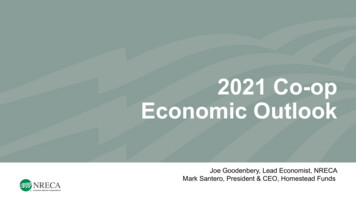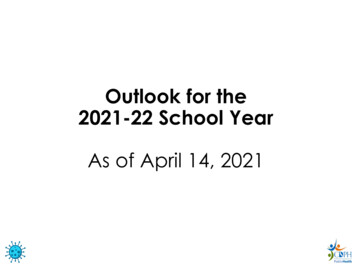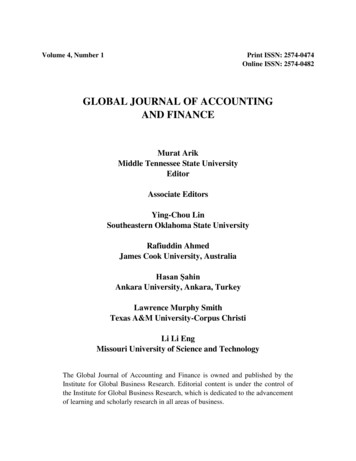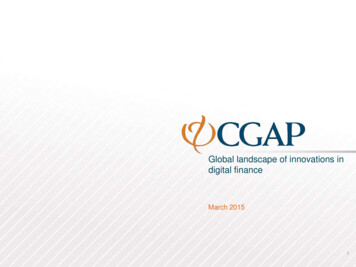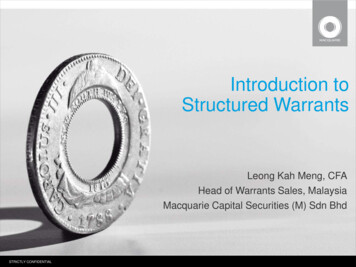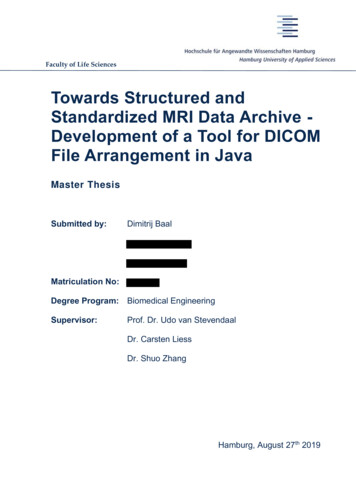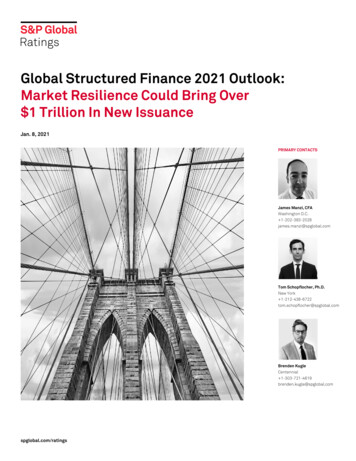
Transcription
Global Structured Finance 2021 Outlook:Market Resilience Could Bring Over 1 Trillion In New IssuanceJan. 8, 2021PRIMARY CONTACTSJames Manzi, CFAWashington D.C. 1-202-383-2028james.manzi@spglobal.comTom Schopflocher, Ph.D.New York 1-212-438-6722tom.schopflocher@spglobal.comBrenden KugleCentennial om/ratings
Global Structured Finance OutlookContentsIntroduction3U.S.Auto Loan ABS6Auto Lease ABS8Commercial ABS10Unsecured Consumer ABS13Non-Traditional ABS16ABCP Latin R45ESG472
Global Structured Finance OutlookH1 - IntroductionIntroduction Global Structured Finance OutlookWhat To Look For Over The Next YearEntering 2021, the impact of the COVID-19 pandemic on global macroeconomic growth and the knock-oneffects on asset prices, market sentiment, interest rates, and consumer credit (to name a few) will remainthe key factors dictating structured finance issuance and performance through the year. And much like ouroutlook for the ongoing recovery of the global economy, performance may continue to be somewhatuneven depending on the specific structured finance asset class or region. With this in mind, we begin the2021 edition of our global structured finance outlook with seven trends and observations to look out for inthe year ahead.1. Downside ratings bias still exists, but a large second wave of downgrades isunlikelyIn 2020, 2,551 structured finance rated tranches experienced at least one negative rating action throughDec. 11 as a result of the pandemic's impact and/or the decline in oil and gas prices (see chart below).While this number includes some classes that were placed on CreditWatch with negative implications andsubsequently affirmed, there were nearly 2,000 related downgrades in 2020. To put this in perspective, the2,300 rating actions in North America (to date, there were none in Canada) accounted for about 6.3% of ourrated book by count.Structured Finance Rated Tranches Having Experienced A COVID-19-RelatedRating Action Through Dec. 11, 2020ABCP—Asset-backed commercial paper. ABS—Asset-backed securities. ABS DFP—ABS dealer floorplan. CB—Covered bonds. CDO—Collateralized debt obligation. CLO—Collateralized loan obligation. CMBS—Commercial mortgage-backed securities. Corp. Sec.—Corporatesecuritizations. CWN—CreditWatch negative. RMBS—Residential mortgage-backed securities. SME—Small and medium-sized enterprises.TOB—Tender option bond. VRDO—Variable rate demand obligation.Source: S&P Global Ratings. Copyright 2021 by Standard & Poor’s Financial Services LLC. All rights reserved.Only a small number of classes currently remain on CreditWatch negative. We don’t foresee anotherdowngrade wave of similar magnitude this year, especially considering that the vaccine rollout has alreadybegun. That said, there remains some risk in certain areas, such as commercial real estate and pockets of3
Global Structured Finance Outlookconsumer/esoteric asset-backed securities (ABS). On the consumer side, further stimulus is a wildcardthat will play into our credit outlook. The collateralized loan obligation (CLO) outlook on both sides of thepond has stabilized, and, while there may be some sporadic actions, we don’t foresee another surge ofdowngrades on the U.S. side, absent another downturn in the ratings for the mostly speculative-gradecompanies (rated 'BB ' or lower) underlying the loans.2. Issuance is set to rebound, led by the U.S. and ChinaAll things considered, issuance remained resilient in 2020. At midyear, in the thick of the first wave of thepandemic, we projected a roughly 25% decline in the full-year 2020 total. The decline turned out to becloser to 7%, largely due to a year-over-year increase in issuance in China, steady figures from Japan, androbust U.S. ABS and CLO volumes. In 2021, we forecast a roughly 14% increase from 2020 levels, to justover 1.2 trillion equivalent, with issuance flat or higher in every major region. We expect China (which wasin a sense “first-in first-out” regarding the pandemic impact) to continue its growth and post a about 15%increase. The U.S. and Europe are set for moderate increases of 15% and 10%, respectively.Global Structured Finance New Issue 0582452520Canada (bil. C )15182025191121Europe (bil. . (bil. US )Asia-Pacific (bil. US )Total APACLatin America (bil. US )Approximate global newissue total (bil. US )(i)We reserve the right to periodically revise these numbers retroactively as new information arises. Covered bonds and ABCP are excluded fromthese totals. F—Forecast. Source: S&P Global Ratings.Copyright 2021 by Standard & Poor’s Financial Services LLC. All rights reserved.3. The commercial real estate downturn remains an area of focusThe commercial real estate sector continues to grab headlines and will certainly remain an area of focus in2021. This is largely due to current pockets of credit distress—namely selected areas of the retail andlodging subsectors—and the potential for the distress to spread to other areas of the market. Indeed,there is a healthy debate about the future performance of office markets, especially in densely populatedgateway cities, and how certain urban multifamily markets will perform if there is a longer-term populationshift away from those cities. These factors have already had an impact on commercial mortgage-backedsecurities (CMBS) ratings in 2020—a trend that may continue into 2021, with U.S. CMBS delinquencylevels still elevated, although off their peaks.4. Forbearance and payment holidays endingThe use of forbearance and payment holidays has benefited consumer ABS, CMBS, and, to some extent,residential mortgage-backed securities (RMBS) credit to this point in the pandemic. We are likely to seethese types of arrangements begin to end as we move through 2021 and will be keeping a close eye on the4
Global Structured Finance Outlookoutcomes. The level of direct stimulus, unemployment benefits, etc. will likely have a considerable impacton certain consumer sectors.5. An uneven recovery for the global economyDue to the new surge in COVID-19 cases and varying levels of lockdown in the U.S. and Europe, oureconomists are forecasting a weaker start to 2021, with full-year global GDP growth now at 5.0%, downfrom 5.3% previously. Forecasts for 2022 and 2023 are for 4.0% and 3.6% growth, respectively.Unemployment is not forecasted to recover to 2019 levels until 2023 or later in most regions, save China.Hope is on the horizon with the news of several successful vaccines, but there is still downside risk to ourbaseline (see "Global Economic Outlook: Limping Into A Brighter 2021," published Dec. 3, 2020).6. LIBOR transition to continueWhile issuance of floating-rate structured finance transactions using LIBOR continued in 2020, mostissuers incorporated robust fallback language into liability transaction documents to minimize adisorderly transition when LIBOR phases out. The biggest challenge going forward continues to be legacytransactions. On Nov. 30, 2020, the ICE Benchmark Administrator issued a consultation with coordinatedsupport from U.S. federal banking regulators that extends the phaseout date for most U.S. dollar LIBORmaturities by 18 months to June 2023. As of this writing, the December 2021 deadline for the four non-U.S.dollar LIBOR currencies remains intact. U.S. banking regulators have also urged banks to stop using U.S.dollar LIBOR in new contracts by December 2021. Therefore, securitization markets will see transactionactivity and developments occur outside the U.S. market first.7. Environmental, social, and governance (ESG) factors to play an expanding role instructured financeThe 'G' in ESG, governance, has long been part of structured finance transactions. The 'E' and the 'S'appear to be growing in influence and have certainly become a more frequent topic of conversation amongmarket participants. Examples include CLOs that highlight ESG in their asset selection, CMBS and greenbuildings (though this has been around for some time via Leadership in Energy and Environmental Designcertifications), clean energy transactions, etc. We have also published Green Evaluations on propertyassessed clean energy (PACE) transactions. Further, ESG factors accounted for numerous rating actions in2020. To be sure, the path forward and the ultimate influence of ESG on structured finance both remainsomewhat unclear at this point, though ESG certainly appears to be gaining in importance.5
Global Structured Finance OutlookH1 – Auto Loan ABSU.S. Auto Loan ABSKey Takeaways New issuance could reach 83 billion in 2021 due to an expected increase in vehicle sales. Delinquencies and losses will likely rise from last year’s levels, which were at record lows due toCOVID-19-related extensions. We expect ratings on investment-grade auto loan ABS to remain stable, while speculative-gradeclasses may be more vulnerable to downgrade.Primary ContactAmy MartinNew Yorkamy.martin@spglobal.com 1-212-438-2538What To Look For Over The Next YearDespite U.S. light vehicle sales declining an estimated 15% to 14.4 million in 2020, auto loan ABS volumedeclined only 9% to 75.3 billion. In fact, GM Financial and Ford Credit issuances increased year over yeardue to growth in their origination volumes through the first nine months of 2020, compared with the sameperiod in 2019. Their higher origination volumes were partly due to attractive loan programs, such as 0%financing on 84-month loans, which were introduced to spur sales. However, bank sector and subprimeissuances declined. The top six 2020 auto loan issuers were: GM Financial/AmeriCredit ( 8.3 billion),Toyota Motor Credit ( 7.9 billion), Ford Credit ( 7.4 billion), Santander Consumer USA ( 7.0 billion),American Honda Finance Co. ( 5.0 billion), and CarMax Business Services ( 5.6 billion).Primary ContactFrank TrickNew Yorkfrank.trick@spglobal.com 1-212-438-1108Given our current forecast for auto sales to increase 14% to 16.4 million units in 2021, we believe auto loanABS could reach 2019’s level of approximately 83 billion. That said, in the current unprecedentedenvironment, performance is difficult to project and will depend greatly on the following factors: The course of the pandemic and the actions taken to halt the spread of the virus, includingrestrictions on certain people-facing businesses; Unemployment levels; The effectiveness of the new round of stimulus checks ( 600 for some individuals) and continuationof enhanced employment pay of 300 a week; The degree to which lenders can continue to offer borrower assistance, such as loan extensions andmodifications;U.S.Subprime Recoveries64.7%66%64%62%60% Lender underwriting standards and policies, which remain under pressure due to the intenselycompetitive environment. Loan terms are continuing to lengthen with a growing percentage of 84month loans in prime pools; and57.9%57.1%58%56%54%terms. These, along with federal stimulus checks and enhanced unemployment benefits, had the effect ofsuppressing delinquencies and losses to record-low levels. And while extension levels have generallydeclined after peaking in April, they started to trend upward again in September for subprime %71%Oct.allowed the borrowers to skip two to four payments and have these added to the backend of their loanPrime RecoveriesSept.Following the onset of the pandemic, lenders provided a record amount of extensions, some of which52%Aug. Used vehicle values and recovery rates, which are likely to continue to soften from their record highlevels in August 2020.6
Global Structured Finance OutlookPrime Auto Loan Extensions, Losses, And DQs7.0%0.8%6.0%0.7%0.6%5.0%0.5%4.0%0.4%3.0%Prime ext (leftscale)Prime losses(right scale)Prime 60 day DQ(right ies. Source: S&P Global Ratings.Copyright 2021 by Standard & Poor’s Financial Services LLC. All rights reserved.Subprime Auto Loan Extensions, Losses, And .0%6.0%5.0%Subprime ext (leftscale)Subprime losses(right scale)Subprime 60 day DQ(right uencies. Source: S&P Global Ratings.Copyright 2021 by Standard & Poor’s Financial Services LLC. All rights reserved.Despite numerous uncertainties, we currently believe credit performance will begin to normalize this year,with delinquencies and losses rising moderately. This is based on our economic outlook thatunemployment levels will remain elevated and won’t return to pre-pandemic levels until 2023, recoveryrates declining from the record high levels reported in August and September, and borrower assistanceprograms, including extensions, becoming less available.Even so, we expect ratings on investment-grade auto loan ABS to remain stable. However, speculativegrade classes, which are confined to subprime, are more vulnerable to downgrades, given their lowercredit enhancement levels and longer time to maturity. The lowest-rated classes are also susceptible tobackend losses associated with loans that have had payment deferrals, which have a higher likelihood ofdefaulting than non-extended loans.7
Global Structured Finance OutlookH1 – Auto Lease ABSU.S. Auto Lease ABSKey Takeaways We forecast issuance volume of 20 billion in 2021, which is slightly higher than in 2020.Primary ContactJennie LamNew Yorkjennie.lam@spglobal.com 1-212-438-2524 We also expect auto lease credit quality and collateral performance to remain stable. ABS ratings are also likely to remain stable.What To Look For Over The Next YearWe expect auto lease ABS issuance of about 20 billion in 2021—slightly higher than 2020’s full-yearvolume of 19.2 billion—and issuers to maintain their usual issuance cadence of two auto lease ABSU.S.transactions per year on average. The COVID-19 pandemic mildly affected auto lease ABS issuance in2020. Prior to the outbreak, roughly 41% of the year’s total volume had already been issued in January andFebruary. Despite the disruption, most issuers were able to resume their usual issuance cadence in thesecond half of the year. The pandemic did, however, reduce BMW's 2020 issuance plans (the companytypically issues at least one auto lease ABS per year), but we expect a return in 2021. And although 2020volumes and our 2021 forecast represent a decline of 10% and 6%, respectively, from 2019 levels (whichwas a peak issuance year for auto lease ABS at 21.2 billion), these levels are still at least 20% higher than2016-2018 volumes (see chart below).U.S. Auto Lease ABS Issuance3025(Bil. 1050201520162019F—Forecast. Source: S&P Global Ratings.Copyright 2021 by Standard & Poor’s Financial Services LLC. All rights reserved.New vehicle lease penetration rates fell below 26% in second-quarter 2020 from an annual historicalaverage of 30%. During this time, despite the pandemic, many captive lenders offered very attractivefinancing options, including 0% annual percentage rates and extended loan terms, to boost vehicle sales.As such, some consumers who would have otherwise leased instead financed their vehicle purchases.These offers have since expired, and we expect leasing volumes to return to usual levels; in fact, the thirdquarter penetration rate was approximately 26.2%. Without significant available incentives, leasingcontinues to be the more affordable option for lower monthly payments.We expect auto lease ABS credit quality and collateral performance to remain stable this year. Residualvalues on returned off-lease vehicles, which has generally followed wholesale used vehicle prices, held upwell and showed resilience despite a one-month decline in April. Used vehicle prices experienced a swiftand significant recovery after April due to new vehicle inventory shortages from stopped production anddealership showroom shutdowns due to COVID-19-related shelter-in-place mandates, resulting in strong8
Global Structured Finance Outlookconsumer demand for used vehicles. Despite this current trend, however, we expect the new vehiclesupply shortage will right-size and used vehicle prices will normalize closer to pre-pandemic levels. Thesteady increase in new vehicle prices will help to preserve some of the demand for used vehicles as a lesscostly option. Available vehicles coming off lease have increasingly skewed toward SUVs and pickuptrucks, further providing consumers with more affordable options to satisfy their continued preference forthese types of vehicles. In addition, the strong credit attributes of the lessees in auto ABS pools, combinedwith robust vehicle liquidation proceeds, have resulted in low credit losses.Auto lease ABS ratings will likely remain stable in 2021, barring any further significant auto manufacturerdowngrades. Throughout 2018-2019, several auto manufacturers were downgraded for various reasons,but none affected our ratings on auto lease ABS because the manufacturers were able to retain theirinvestment-grade status. However, weaker performance metrics in 2020, especially in light of thepandemic, led S&P Global Ratings to lower its issuer credit rating on Ford Motor Co. to 'BB ' (speculativegrade). As the rating on an auto manufacturer declines to speculative-grade status, the potential for abankruptcy (and the relative impact on vehicle residual values) becomes increasingly significant and couldhave a material negative effect on the rated auto lease ABS. Ford Motor’s downgrade has led to increasedresidual haircuts under our ABS analysis and resulted in a one-notch downgrade to one class ofsubordinate ABS notes. We currently have no outstanding rated auto lease ABS for which the relatedmanufacturer is on CreditWatch negative (which indicates the likelihood of a downgrade within 90 days).Auto lease ABS transactions typically include robust structures with credit enhancement that growsquickly due to deleveraging, providing more credit support as the transaction seasons.9
Global Structured Finance OutlookH1 - Commercial ABSU.S. Commercial ABSKey Takeaways We expect commercial ABS issuance of between 28 billion and 30 billion in 2021, led by captiveequipment issuers. While payment deferrals varied across commercial equipment issuers in 2020, the current stableperformance shows the effectiveness of the responses to mitigating short-term liquidity concerns. We expect nondiversified floorplan deal performance to remain stable, with expected lossesremaining near zero, primarily due to manufacturer support.Primary ContactSteve MartinezNew Yorksteve.martinez@spglobal.com 1-212-438-2881What To Look For Over The Next YearCommercial ABS issuance volume is expected to increase, with further potential to the upside dependingon how fast the economy recovers from the COVID-19 pandemic in 2021. Issuance volume for all fourcommercial ABS segments (captive equipment, independent equipment, fleet lease, and floorplan) allexperienced significant year-over-year declines in 2020 due to the pandemic and its negative impact oneconomic growth. Commercial ABS issuance volumes fell approximately 40.0% to slightly over 21 billionin 2020 from 35 billion in 2019. The decline was most pronounced in the dealer floorplan andindependent equipment segments, which both experienced decreases of slightly above 50% from 2019. Itis not surprising that these two segments experienced the largest drops, considering that foot traffic atSecondary ContactJason McCauleyCentennialjason.mccauley@spglobal.com 1-303-721-4336many dealership lots and small retail businesses came to a complete halt for at least few months due tothe
The top six 2020 auto loan issuers were: GM Financial/AmeriCredit ( 8.3 billion), Toyota Motor Credit ( 7.9 billion), Ford Credit ( 7.4 billion), Santander Consumer USA ( 7.0 billion), American Honda Finance Co. ( 5
